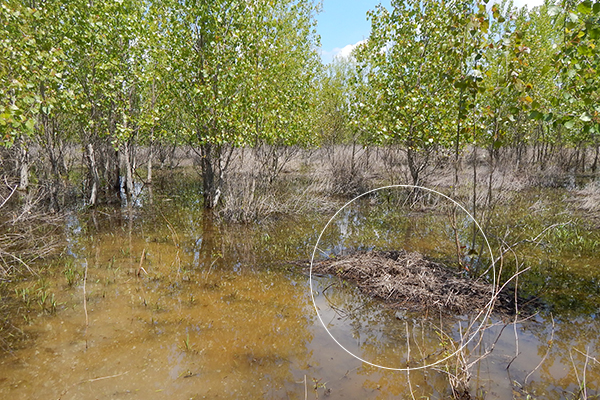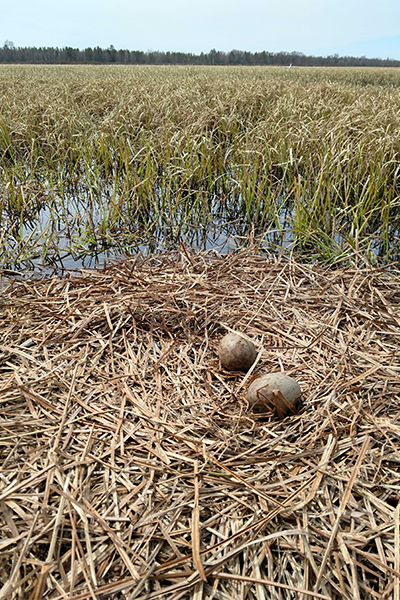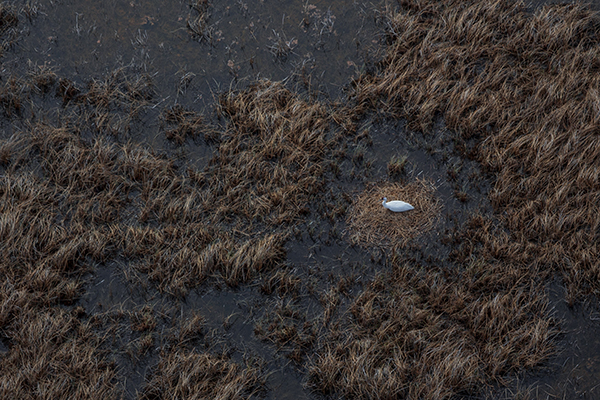
In 2001, a migratory Whooping Crane population called the Eastern Migratory Population, was reintroduced to the eastern United States. The plan was for these Whooping Cranes to nest in Wisconsin and migrate to Florida for the winter. Today, Whooping Cranes in this population do not choose to winter as far south as Florida. Instead, most of these Whooping Cranes spend their winters further north, and over one-third of the population winter in Indiana at refuges such as Goose Pond Fish and Wildlife Area, Jasper-Pulaski Fish and Wildlife Area and Cane Ridge Wildlife Management Area. Indiana has increasingly become an important space for Whooping Cranes after they first began wintering here in 2007.

Despite the large shift in the wintering range of the Eastern Migratory Population, there has been very little change in their breeding range, as the vast majority of this population migrates to Wisconsin every spring to breed at Necedah and Horicon National Wildlife Refuges and White River Marsh State Wildlife Area – exhibiting high nest site fidelity. One reason for this is Whooping Cranes tend to be highly philopatric, meaning they typically establish breeding territories close to the location where they were hatched and raised. However, it is still possible for Whooping Cranes to explore and expand to new areas. This may be beneficial as the population grows and they seek new places to breed.
In 2015, a young Whooping Crane pair, both approximately six years old, built nests not only outside of the traditional breeding range in Wisconsin but in their wintering range in Indiana! These Whooping Cranes were the first pair to nest in Indiana in 150 years. It is believed that Whooping Cranes would have nested in the Grand Kankakee Marsh in northern Indiana before it was drained in the late 1800s.
These Whooping Cranes first paired in the fall of 2014 at Necedah National Wildlife Refuge in Wisconsin. They then migrated together to Tern Bar Slough Wildlife Diversity Area in Gibson County, Indiana, for the winter. Typically, Whooping Cranes that winter in southern Indiana will leave their wintering grounds and start migrating back to Wisconsin in March. However, in 2015, the pair was still observed on their wintering grounds in late March in a remote location with minimal human disturbance and plenty of suitable nesting habitat. In late April, the male Whooping Crane was observed alone and alarm calling, which Whooping Cranes typically do in response to a threat. Searches were then conducted to check on the female, and biologists found three nest platforms. Unfortunately, the female Whooping Crane was found dead nearby, likely due to predation.
These were the first nests the male Whooping Crane had ever built, while the female had built nest platforms in previous years in Wisconsin with a prior mate, but she had never laid eggs. The three nests the pair built in Indiana were similar to those built by Whooping Cranes in Wisconsin. These Indiana nest platforms were roughly 4 by 6.5-foot ovals made of dead sedges and located in shallow water a little over half a foot deep. Two of the nests were built in an open wetland with minimal tree cover, while the third was in a smaller open wetland surrounded by young cottonwood trees. It is unknown if the pair had laid any eggs together as no evidence of eggs was found on the nests. The murky water surrounding the third nest, where the female was found, was never checked for eggs or eggshells.
Nesting outside of typical breeding areas is not unique to Whooping Cranes. It has been documented in several other bird species and is necessary for an extirpated species in order to successfully recolonize its historic range. For example, as Sandhill Crane populations grew after experiencing historic low numbers in the 1940s, they continued to expand their breeding range and successfully reclaimed much of that historic area.

Even though this Whooping Crane pair did not successfully raise chicks, by building the three nest platforms they showed that Indiana has the potential to support not only wintering Whooping Cranes but breeding Whooping Cranes as well. However, the continuing ability of Indiana’s wetlands to support Whooping Cranes is uncertain. Whooping Cranes rely on wetlands year-round as a safe place for them to roost at night, and Indiana has lost over 85% of its historic wetlands due to agricultural and urban expansion. Unfortunately, Indiana is likely to lose even more wetlands as a recent legislature was passed that further reduces wetland protections. To secure Indiana as both a wintering and potential breeding location for Whooping Cranes, the remaining wetlands must be valued and protected. It is important for people who own or manage properties containing wetlands to continue to protect and steward those wetlands. Furthermore, it is critical for all people to support comprehensive and extensive wetland protections and educate others on the importance of wetlands to ensure that Whooping Cranes can continue to find safe wintering grounds in Indiana.
We thank Amy Kearns, Hillary Thompson, and Allisyn-Marie Gillet, the authors of the summarized manuscript “Whooping Crane Nest Building in Southwest Indiana”, for providing us with permission to share their work.
References
Kearns, A. J., Thompson, H. L., Gillet, A. T. Y. (2022). Whooping Crane Nest Building in Southwest Indiana. Proceedings of the North American Crane Workshop, 15, 128-133.
Story submitted by Lauren Benedict, Outreach Biologist Assistant – Indiana, and Stephanie M. Schmidt, Lead Outreach Biologist, International Crane Foundation
